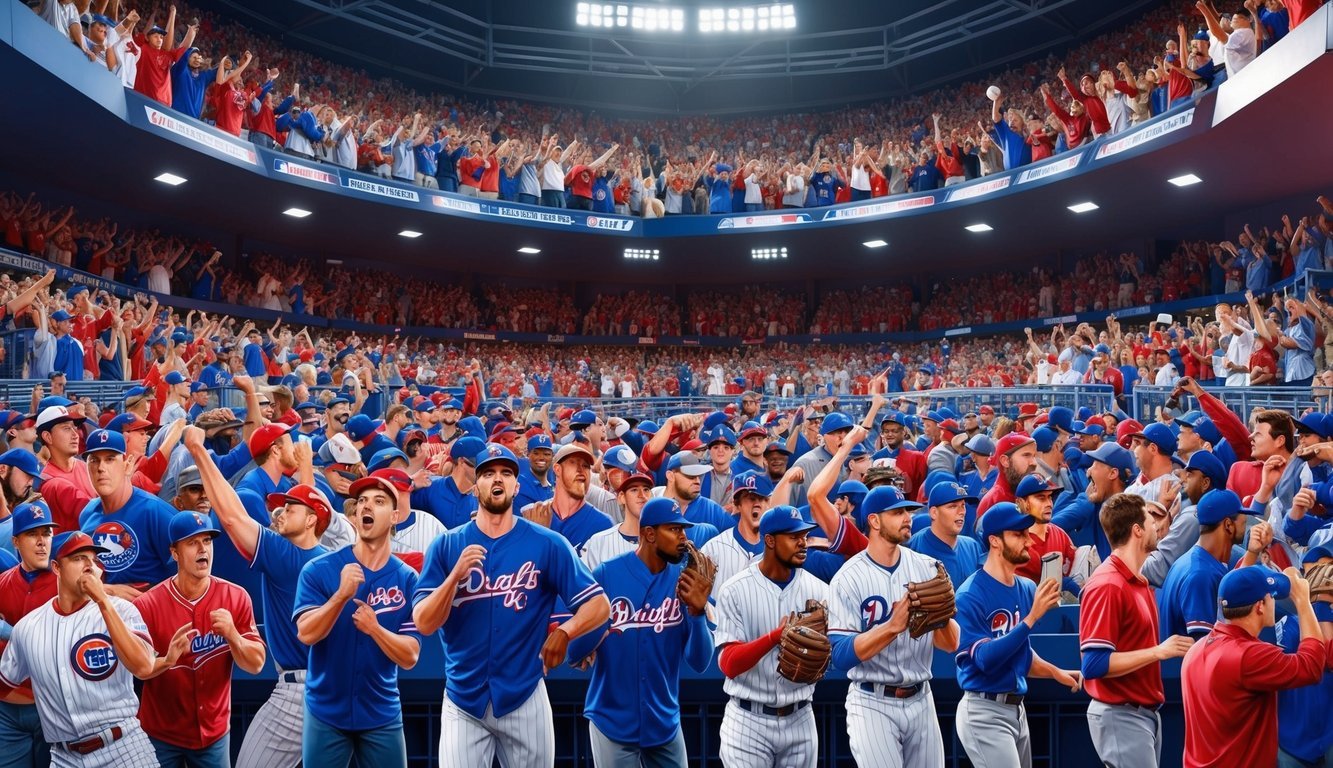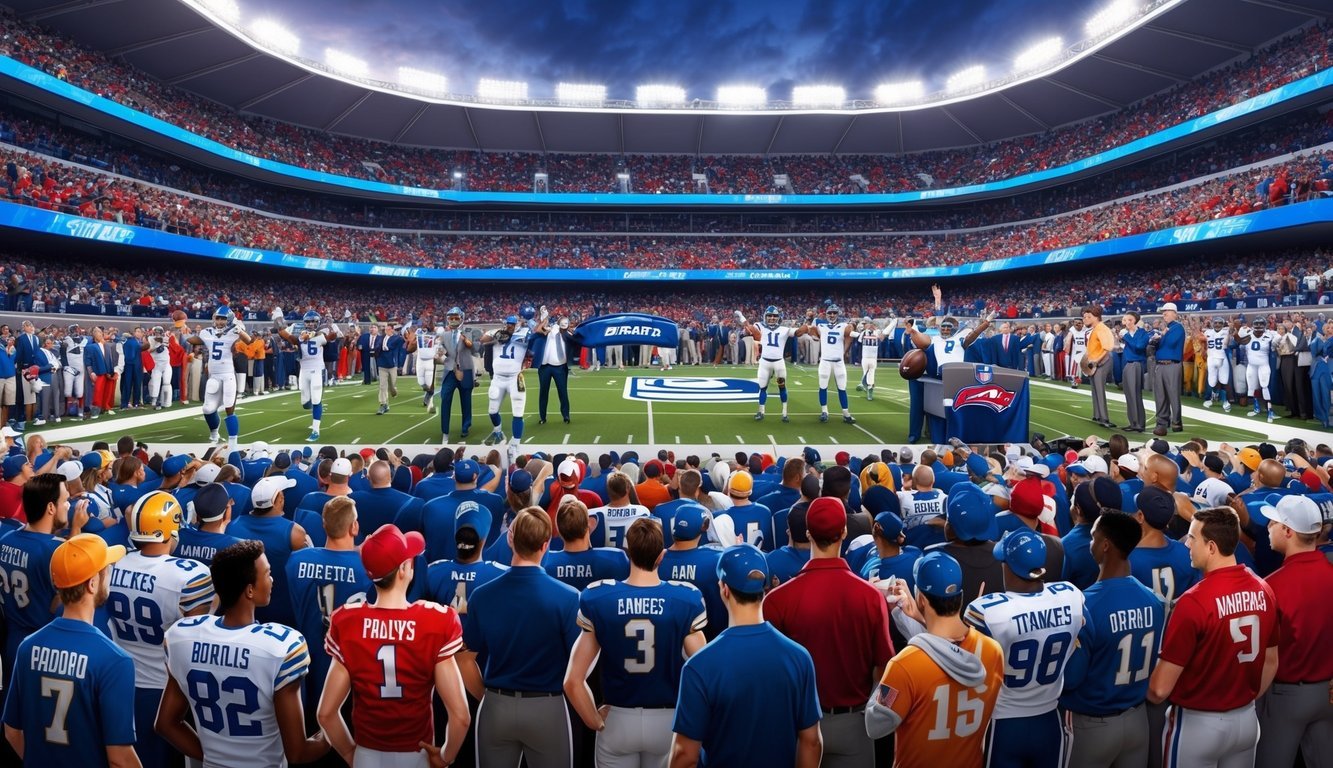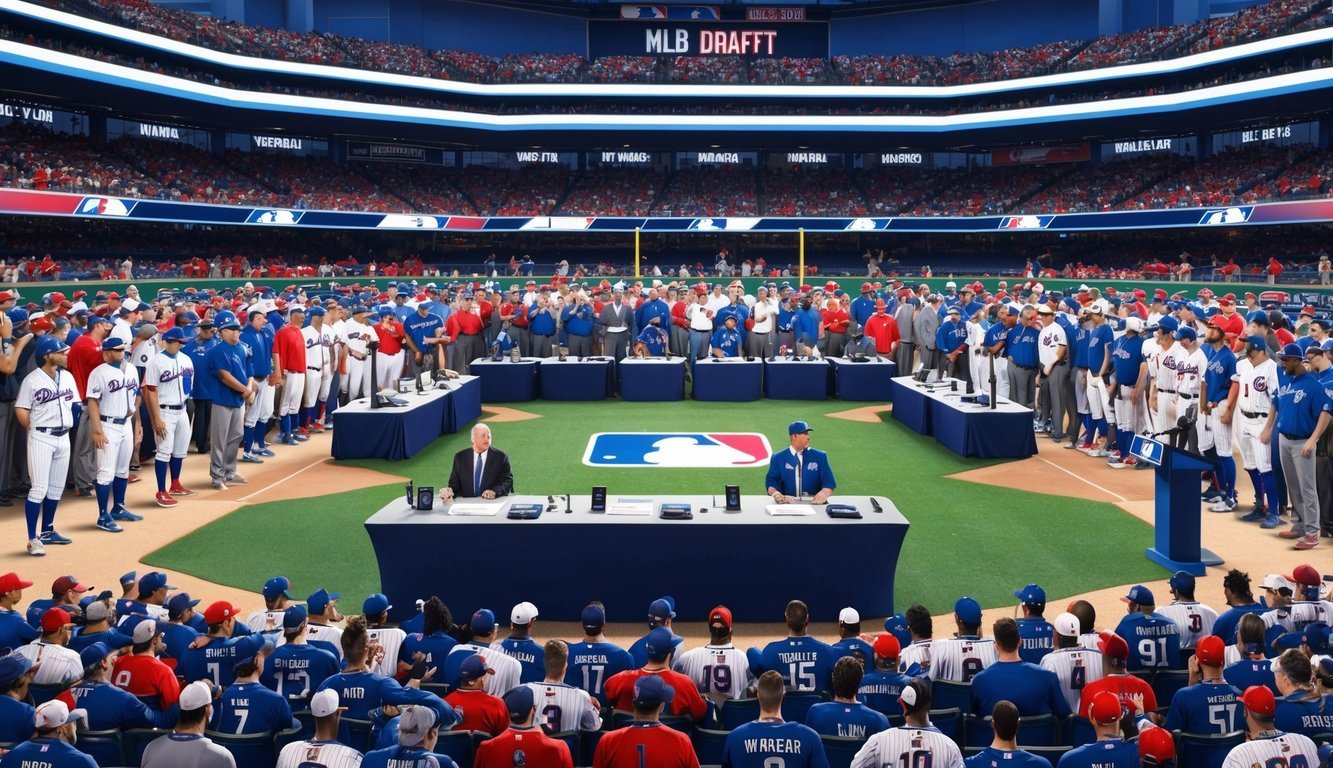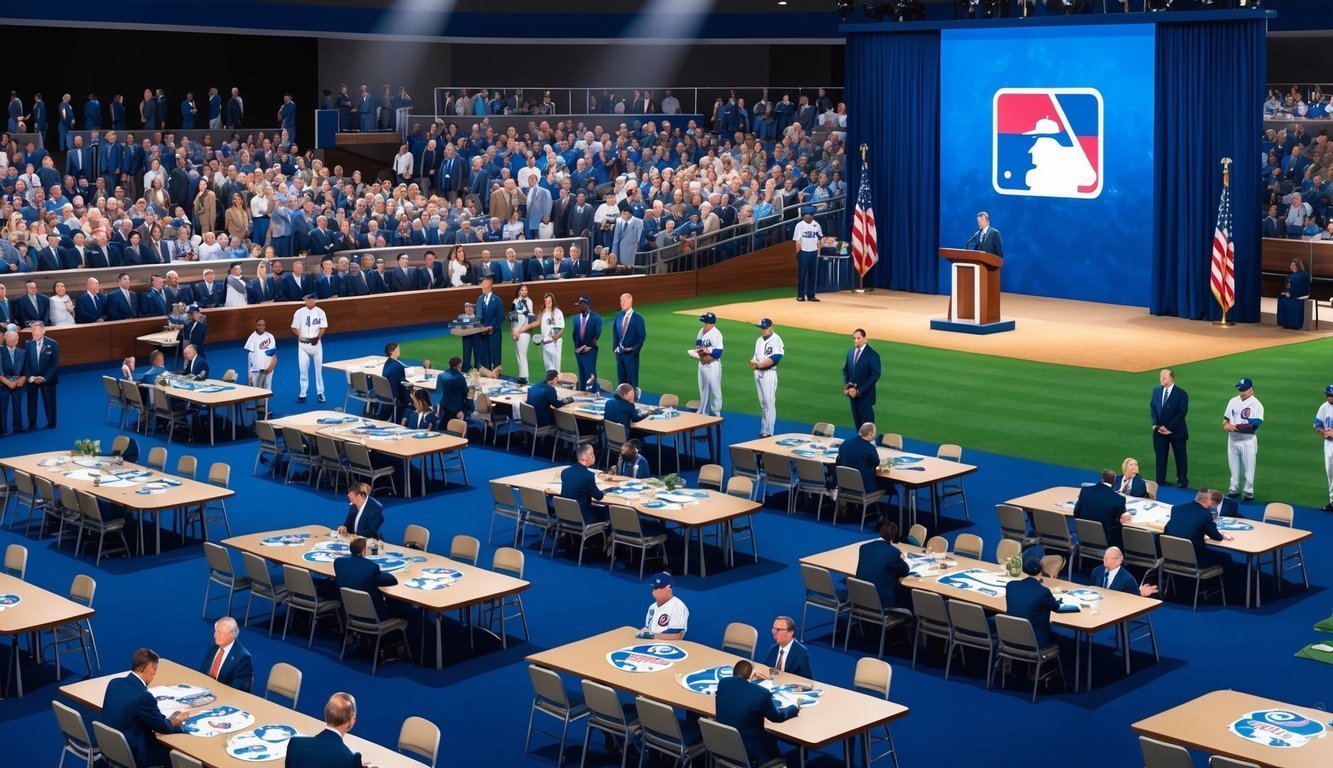The annual MLB Draft is a pivotal event in the baseball world, shaping the future of teams and young players alike.
Each summer, Major League Baseball teams gather to select top amateur talent from high schools, colleges, and other baseball clubs across the country.
Teams choose players based on the previous season’s standings.
The worst-performing teams get earlier picks to help maintain competitive balance.
This system gives struggling franchises a chance to acquire potentially game-changing prospects and rebuild their rosters.
The MLB Draft has evolved over the years, currently consisting of 20 rounds spread across three days.
It’s an exciting time for baseball fans, as they watch their favorite teams make selections that could impact the franchise for years to come.
From future All-Stars to hidden gems, the draft is where many MLB dreams begin to take shape.
History of the MLB Draft
The MLB Draft has evolved significantly since its inception, shaping the landscape of professional baseball.
It has produced many star players and changed how teams acquire young talent.
Origins and Evolution
The MLB Draft began in 1965 as a way to distribute amateur players fairly among teams.
Before this, clubs could sign any amateur player they wanted, often leading to bidding wars.
The draft initially had three phases – June, January, and August.
By 1986, it was streamlined into a single June event.
Over the years, the draft format has changed.
It started with unlimited rounds but was eventually capped.
In 2024, the draft consists of 20 rounds.
A significant change came in 2023 with the introduction of a lottery system for determining draft order, replacing the previous method based solely on win-loss records.
Notable First Picks
The first overall pick in the MLB Draft often generates excitement and high expectations.
Some notable first picks include:
- Ken Griffey Jr. (1987) – Hall of Famer, 13-time All-Star
- Chipper Jones (1990) – Hall of Famer, 1999 NL MVP
- Alex Rodriguez (1993) – 14-time All-Star, 3-time AL MVP
- Joe Mauer (2001) – 6-time All-Star, 3-time batting champion
- Stephen Strasburg (2009) – World Series MVP, 3-time All-Star
These players went on to have successful careers, though not all top picks achieve stardom.
The draft remains an exciting event for fans and a crucial tool for teams to build their future rosters.
The Draft Process

The MLB Draft is a complex process involving player eligibility, team selection order, and special compensation rounds.
It’s a crucial event for teams to acquire new talent and shape their future rosters.
Eligibility and Selection
Players from high schools, colleges, and junior colleges in the United States, Canada, and Puerto Rico are eligible for the MLB Draft.
High school players must have graduated and not yet attended college.
College players must have completed their junior or senior years or be at least 21 years old.
Teams scout potential draftees extensively, evaluating their skills, physical attributes, and potential for development.
The draft consists of 20 rounds, with each team making one selection per round unless they have additional compensation picks.
Draft Order and Lottery System
The draft order is determined by the previous season’s standings, with the worst teams picking first.
However, MLB introduced a lottery system in 2022 for the top six picks to discourage intentional losing.
All non-playoff teams are entered into the lottery, with the three worst records having the highest odds of securing the top pick.
The remaining teams’ odds decrease based on their win-loss records.
Compensation Picks and Competitive Balance Rounds
MLB offers compensation picks to teams that lose qualified free agents.
These picks are typically placed between the first and second rounds of the draft.
Competitive Balance Rounds A and B provide additional picks for small-market and low-revenue teams.
Round A occurs after the first round, while Round B follows the second round.
These extra picks aim to help smaller market teams compete with larger, wealthier franchises in acquiring top talent through the draft.
Impact on Teams and Players

The MLB draft shapes the future of franchises and aspiring baseball stars.
It influences roster construction, player development paths, and the competitive landscape across the league.
Team Strategies
MLB teams approach the draft with varying philosophies.
Some prioritize college players for quicker impact, while others target high-upside high schoolers.
The Yankees and Dodgers often mix these approaches, balancing immediate needs with long-term potential.
Small-market teams like the Pirates and Athletics may focus on cost-effective selections to maximize value.
Draft position affects strategy too.
Top picks offer chances at elite talent, but smart scouting can unearth gems in later rounds.
The Mets have found success with both early and late-round picks in recent years.
Teams must also consider signability.
Bonus pool limitations force clubs to allocate resources wisely across their selections.
Player Development
The draft marks the start of a player’s professional journey.
Most draftees begin in the minor leagues, working their way up through various levels.
Organizations like the Cardinals and Twins are known for strong player development systems.
They nurture raw talent into MLB-ready contributors.
Development timelines vary widely.
College draftees may reach the majors faster, while high school picks often require more patience.
The Angels’ Mike Trout, for example, debuted at 19, while others might not see MLB action until their mid-20s.
Teams invest heavily in coaching, facilities, and technology to support draftees’ growth.
The goal is to maximize each player’s potential and prepare them for the big leagues.
Annual Event Highlights
The MLB Draft has become a major spectacle in recent years, drawing significant attention from fans and media alike.
It now takes place during All-Star Week, creating a baseball extravaganza that celebrates both current stars and future prospects.
All-Star Week and MLB Draft
The MLB Draft coincides with All-Star Week, creating an exciting multi-day baseball celebration.
Fans gather to watch top amateur players get selected by their favorite teams.
The event typically occurs in June, just before the All-Star Game.
Teams like the Braves, Orioles, Marlins, Giants, and Cubs eagerly await their turn to pick future stars.
The draft order is determined by the previous season’s standings, with the worst teams picking first.
Prospects and their families attend the event, adding to the emotional atmosphere as dreams come true on stage.
The first round is particularly thrilling, with top picks often receiving immediate attention and expectations.
Media Coverage and Public Interest
ESPN and MLB Network provide extensive coverage of the draft, offering expert analysis and player profiles.
Mock drafts become increasingly popular in the weeks leading up to the event, with fans and analysts trying to predict each team’s selections.
Social media buzzes with draft-related discussions, as fans debate potential picks and share their excitement.
Many baseball enthusiasts tune in to watch the first round live, eager to see which young talents their team will acquire.
The draft has become a key date on the baseball calendar, rivaling other major sports drafts in terms of fan engagement.
It offers hope for struggling teams and the promise of future success, keeping fans invested in their favorite clubs’ long-term plans.
Recent Drafts and Emerging Trends

The MLB draft continues to evolve, with recent years showcasing exciting talent and notable trends.
College powerhouses and high school phenoms have made their mark, shaping the future of the sport.
As teams refine their scouting strategies and embrace advanced analytics, the importance of thorough mlb baseball teams performance analysis has never been more crucial.
This analytical approach helps organizations identify not just raw talent, but also players who fit their specific needs and strategies.
As the draft unfolds each season, the combination of traditional scouting and data-driven insights continues to transform the landscape of player selection, paving the way for the next generation of superstars.
The 2023 MLB Draft Review
The 2023 MLB draft was a showcase of exceptional talent.
Paul Skenes, a standout pitcher from LSU, was selected as the first overall pick by the Pittsburgh Pirates.
His electric fastball and polished repertoire made him a coveted prospect.
Nolan Schanuel, a first baseman from Florida Atlantic University, was another notable selection.
The Los Angeles Angels drafted him 11th overall, impressed by his advanced hitting approach and power potential.
Georgia, Oregon State, and Vanderbilt continued their tradition of producing top-tier talent.
These college programs saw multiple players selected in the early rounds, highlighting their role in developing MLB-ready prospects.
Prospects to Watch
The 2024 draft class is shaping up to be equally exciting.
Charlie Condon, an outfielder/third baseman from Georgia, is currently ranked as the top prospect.
Teams picking early find him a tantalizing option because of his versatility and power.
Travis Bazzana, a second baseman from Oregon State, is another name to watch.
Scouts are buzzing about his combination of speed and contact skills.
Jac Caglianone from Florida is an intriguing two-way player.
He showcases potential both as a first baseman and left-handed pitcher.
This versatility could make him a valuable asset for MLB teams.
UCLA continues to produce top talent, with several players expected to be selected in the early rounds of the 2024 draft.
